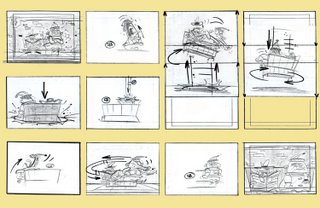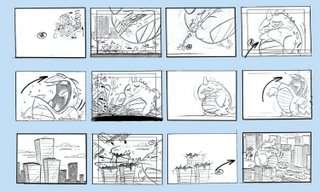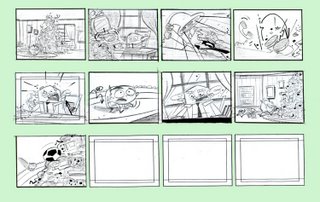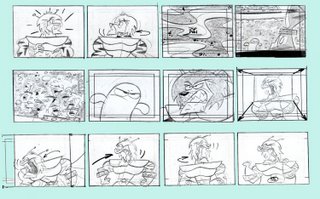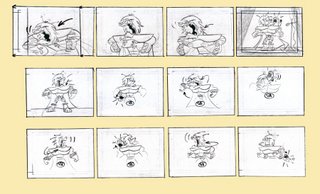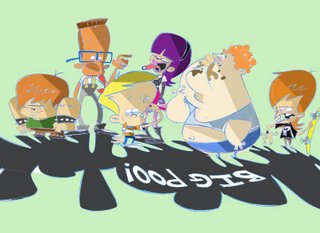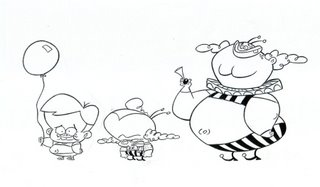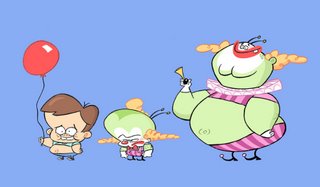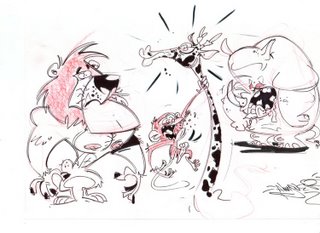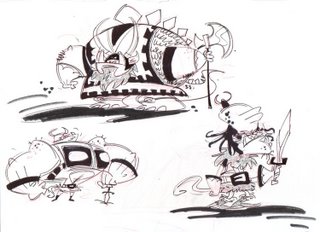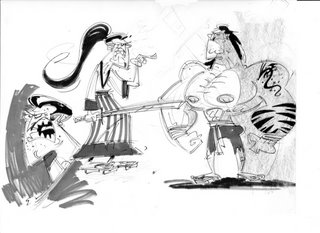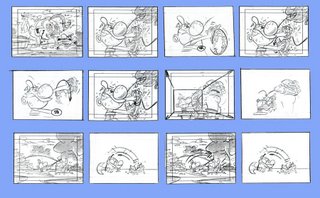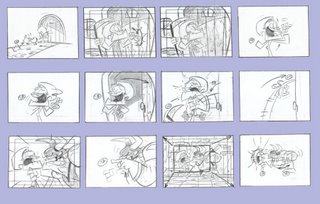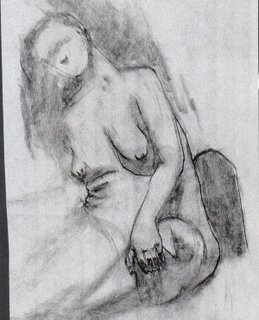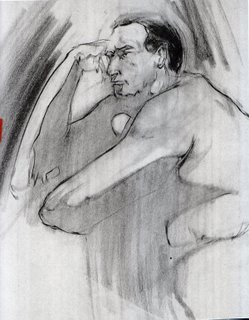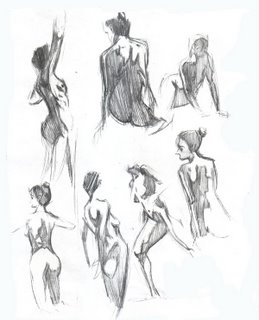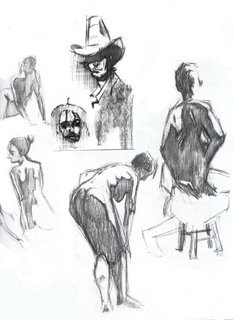ALEX ALMAGUER INTERVIEW
Character Designer and Story-Boarding.
Thursday, March 30, 2006
BROUGHT TO YOU BY THE CHARACTER DESIGN BLOGSPOT
IF YOU WOULD LIKE TO SEE MORE CHARACTER DESIGNERS GO TO THE HOME PAGE BY CLICKING HERE
THE INTERVIEW
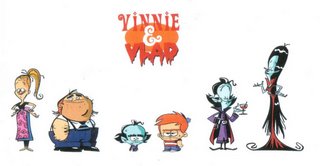
Tell me a little bit about yourself, about your life? Where did you go to school, and what classes did you study? What helped prepare you to become the artist that you are today?
I guess the madness all started back in High School where as fate would have it, I wound up attending Rowland High School. This was the only school I knew about that had an incredible animation program in it. Despite being hated by most of the teachers and being a straight “D” student, this is where I would first get my foundation in animation. The students there actually got to make their own 2-D or 3-D films as class projects and got to learn first hand the process of making animated films. I was hooked like a crack-head. As high school was ending I realized that I had no interest in going to college or any university and that I’d probably have to go work with my dad doing construction or something, that is until I found out about Cal Arts.
I spent two years at Cal Arts and at the same time I was sneaking into classes at Art Center. (Sorry to any of the instructors that thought I was actually a student there.) I took life-drawing classes at A.S.I.F.A. in Burbank with Dave Brain(a brilliant artist) for a few years then I enrolled at “The Associates of Art” in Sherman Oaks. At Cal Arts though, I felt like I wasn’t getting the proper drawing foundation I so needed, so after the second year I was out of there. Soon after leaving, I got my first ever job in the industry. It was a storyboard position on “Pinky and the Brain” at Warner Bros.
Looking back though, I’d say that keeping a sketchbook was one of the most invaluable tools I ever had. I drew everything I could whenever I could. I went to malls, restaurants, zoos, parks, etc. (Not coffee shops, cause they weren’t on every corner block like they are now.) After my drawing classes I would go home and draw another 5-6 hours. You gotta love to draw. Straight up.
How do you go about designing a character, and what goes through your mind, from start to end?
Before my pencil even hits the paper, I gotta have a sense of the character’s personality. The more I know break down a character’s personality the easier it is for me to bust it out. In most cases I like to go through all kinds of different variations of a character, exploring different shapes and sizes and maybe even re-thinking my approach. If pencil isn’t working for me to achieve the design I’m looking for I’ll break out a brush pen, or marker, or crayon, or a bar of soap, whatever it takes. Rarely, do I just go with the first design of a character even if it feels right. I’ll put it aside, and try it again. You burn through a lot of paper like this but this way forces you to see a design in different ways.
What do you think really helps you out in designing a character?
Something as simple as jotting down notes about a character will help immensely in getting to know the character I’m drawing. The same thing applies when I’m trying to come up with gags and dialogue for a board.. I’ll need to write and re-write ideas down to figure out if a scene will work and be funny before I start drawing it out. I’ll have paragraphs written out in my sketch books of just ideas I’m working on or character descriptions. The quickest way of coming up with new characters to design that I found is to simply weave a story around them, weather it’s an idea for a short or a series, or even just a funny situation. So instead of just sitting down and telling yourself, “Ok, today I’m gonna draw a gorilla.” Go ahead and develop a whole story around that gorilla or whatever character you decide you wanna draw and create a whole world around your character.
From your own experience and maybe from some people that you know, what should we put in our portfolio and what should we not?
Getting into the industry is tricky. I’ve heard all kinds of advice from people I work with as to what to put into a portfolio. My advice would be to definately gear your portfolio to whatever position or goal you’re trying to achieve. If boards are your thing, bust some boards in it. Or if character design floats your boat, put in some of your best designs into your portfolio, but always be original. With a boarding portfolio, try to come up with your own short sequences and ideas. Show creators or recruiters of course wanna see if you can know angles, acting, design, staging and all that but more so they wanna how well you can think and be creative with your boarding. For character based portfolios, include character expressions and poses showing attitude and personality, turnarounds, styles, etc. Showing life drawing has always been a border issue. I’ve had recruiters just yawn and flip past my life drawings and animal drawings and go straight to my character designs and boards. Still, I think if you’re quite proud of your life drawing, you can always make a small section for them in the back. Also, include a sketchbook. I myself, would rather look at an artist’s sketchbook than a portfolio only because it reveals more of an artist’s thinking and talent.
What are some of the things you have worked on?
Well, I started on “Pinky and the Brain,” at Warner Bros. Then moved onto “Histeria!” At Cartoon Network, I worked on “Johnny Bravo, PowerPuff Girls, Time Squad, Evil Con Carne and Foster’s Home for Imaginary Friends.” At Nickelodeon I did some work on “Fairly Odd Parents” and “My Life As A Teenage Robot.” Currently, I’m working as a storyboard artist on “The Grim Adventures of Billy & Mandy.”
What are you working on now?
I just finished up on “The Grim Adventures of Billy and Mandy” 90 min.special which will be a straight to dvd release along with premiering on Cartoon Network. We got season 6 of “Billy & Mandy” in full swing which by the looks of things is going to a wild one. Stay tuned. For those going to the San Diego Comic Con this year, be sure to check out the “Billy and Mandy” panel. We’re all going to be there representin’ the show in full effect and premiering two brand spankin’ new episodes.
Where is the place you would like to work if you had a choice?
There’s no real place I’d like to work for, rather I would want to get the chance to create my own show. It would be completely gag driven and story driven. Something I think that’s missing from today’s cartoons which are all shine and no substance.
Who do you think are the top character designers out there?
If we’re talking about the top designers I’d have to throw a few names into the hat of people that I’ve worked with before. Marc Perry, Phil Rynda, Anna Chambers, Pete Oswald, Adam Burton, Dan Haskett, Lynell Forestall, Ronnie and Louie Del Carmen, Octavio Rodriguez, Serapio Calm, just to name a few. As far as great board artists go: Brett Varon, Carl Greenblatt, Vaughn Tada, Paul McEvoy, Ian Wasseluk, Mike Diedrich. There’s a whole lot more I’m leaving out. I’m really inspired by a lot of graf artists as well. Guys like Mear One, Brok & Alex, Cope 2, Grave One, and Keen One are definitely holding it down. I recommend any designer to check out the work of these incredible artists and painters. There’s just so much untapped talent out there it’s ridiculous.
How do you go about coloring the character, what type of tools or media do you use?
As far as color, I mainly use markers right on the spot. I like keeping the energy and rawness of a drawing and with a quick hit of a marker you can add a nice touch of color without having your design look too tight. Rarely, do I render the heck out of a design. On more finished pieces, I might scan them into my computer and drop some color on them through Photoshop or Illustrator
What part of designing a character is the most fun and easy, and what is the most hard?
I’d say the hardest part of designing is trying to come up with a character without knowing where to go. I’ll spend hours drawing and re-drawing the same design over and over again until I ultimately just light my desk on fire and jump out the window into moving traffic. Sometimes, just out of laziness I’ll go ahead and start trying to design a character without first figuring out who the character is and each time I pay the consequences. It may come easier to others, but for myself, I really need to have a clear picture of the type of character I’m trying to draw. On the other hand, the most fun I’ve had designing is when you actually capture a smidgeon of what’s in your head on paper. It’s a beautiful thing.
What is your most favorite subject to draw? And why?
Of all things, I’d say I get the most enjoyment out of drawing zany cartoony characters. I like pushing the shapes of designs as far as they can humanly go weather it be animals or people or monsters.
What inspired you to become an artist?
My inspiration to be an artist came from way back. My dad and I use to watch the old Merrie Melody cartoons and laugh our “nalgas” off. I always tripped out on how just simple moving drawings could capture such perfect comedic timing and emotion. Plus, it was either be an artist or pour concrete for a living. I think I chose the right career.
What are some of the neat things you have learned from other artists that you have worked with or seen?
Being around so many incredibly gifted artists on a daily basis has opened my eyes as to the many kinds of different styles and ways of designing there can be. I’m constantly inspired by the works of others that it only strengthens my own art. I encourage aspiring artists to never playa hate on anyone and just learn to respect other people’s work. While developing as a designer and artist I’ve gotten some great advice from veteran artists telling me to “loosen up” and “vary the shapes in your designs” and to “constantly push the expressions and poses” in my characters. You never really stop learning.
What wisdom could you give us, about being an artist? Do you have any tips you could give?
What I’ve learned on the way, and what I’m still learning to this day is to learn to DRAW EVERYTHING. Draw cars, people, animals, pets, yo mama, your friend’s mama, buildings, trees, whatever. When writing for your own storyboards so much energy and time is spent on coming up with funny gags and dialogue and working out the story that there really is no time to get caught up on something you can’t draw. Stay loose and try to soak up as much knowledge as you can. That’s where carrying a sketchbook comes into play. Draw from life as much as possible then caricature the heck out of it. Make it funny, make it dynamic, make it breathe, make it come to life. Mostly though, stay motivated and humble. Peace.
If people would like to contact you, how would you like to be contacted?
Anyone is free to check out my blog. It’s @ Alexpoo.blogspot.com I’m gonna try to keep it updated with character stuff and storyboards. My e-mail is: Alx_05@yahoo.com
Keep an eye out for a book on storyboarding being released sometime this year by Dave Brain. I had the
Subscribe to:
Posts (Atom)
